![]()
Aroids and other genera in the Collection
Take the Tour Now?
Orchids
The
Exotic Rainforest
Plants in
the Exotic Rainforest Collection
Images on this website are copyright protected. Contact
us before attempting to reuse.
In depth information on how to grow Philodendron species, Click this Link
Within our collection we have many species of Philodendron.
If you are seeking other photos,
click this link
Meconostigma Philodendrons
do climb trees!
Philodendron 'Marijke'
A
registered cultivar
A
putative hybrid of
Philodendron goeldii
G.M. Barroso
and
Philodendron solimoesense
A.C. Sm. (Albert Charles Smith)
from the collection of Joep Moonen in French Guiana
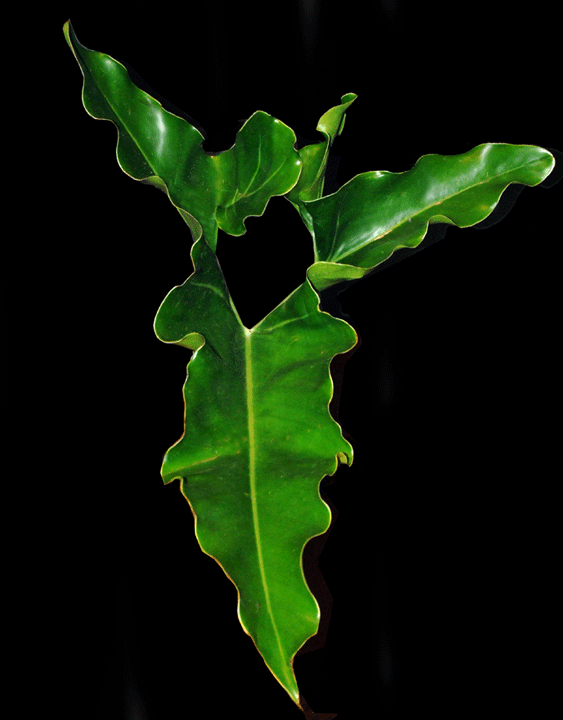
Philodendron 'Marijke'
Correctly pronounced Maryke
A
putative hybrid of
Philodendron goeldii
and
Philodendron solimoesense
Putative: commonly believed or accepted usage by supposition but without the result of factual proof.
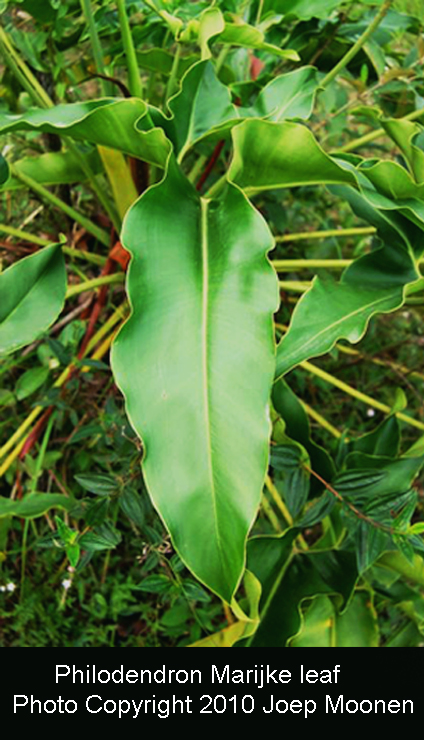 Philodendron 'Marijke' (Mary-ke) is a
natural Philodendron hybrid (subgenus Meconostigma) discovered by my friend Dutch naturalist Joep Moonen
(pronounced Yupe) in
French Guiana. However, the specimens found in private collections as
it exists today are a reconstruction of that hybrid even though the
pollination occurred naturally. This article explains how Philodendron
'Marijke' came to be reconstructed and how Joep would eventually name the
specimen he found and reconstructed in honor of his lovely wife Marijke. Dr. Tom Croat
Ph.D., P.A. Schulze Curator of Botany
of the Missouri
Botanical Garden in St. Louis has said he considers Joep to be his "eyes and
ears" in the rain forest. In October, 2008 Joep registered
Philodendron 'Marijke' as a registered cultivar.
Philodendron 'Marijke' (Mary-ke) is a
natural Philodendron hybrid (subgenus Meconostigma) discovered by my friend Dutch naturalist Joep Moonen
(pronounced Yupe) in
French Guiana. However, the specimens found in private collections as
it exists today are a reconstruction of that hybrid even though the
pollination occurred naturally. This article explains how Philodendron
'Marijke' came to be reconstructed and how Joep would eventually name the
specimen he found and reconstructed in honor of his lovely wife Marijke. Dr. Tom Croat
Ph.D., P.A. Schulze Curator of Botany
of the Missouri
Botanical Garden in St. Louis has said he considers Joep to be his "eyes and
ears" in the rain forest. In October, 2008 Joep registered
Philodendron 'Marijke' as a registered cultivar.
This unusually rare Philodendron hybrid has been observed only once in the rain forests of French Guiana. The one time Joep saw the aroid in the wild was in 1995 at Crique Cavalet, French Guiana. Crique Cavalet is crossed by the national road RN2 approximately 12 km (7.45 miles) from the b of French Guiana with Brazil.
Despite information to the contrary found on various internet sites claiming members of Philodendron subgenus Meconostigma do not climb, the specimen Joep saw was attached to a tree growing at approximately 6 meters (20 feet) above the forest floor. It is well documented in botanical science that Meconostigma species do in fact climb a host tree and may grow very high against their host. Meconostigma species can be observed not only in rain forest but on the research properties of Fairchild Tropical Botanic Garden in Miami, FL growing high into the trees!
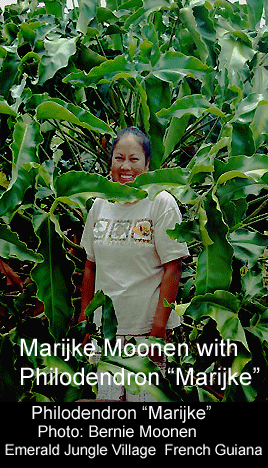 Since more than a few sources
appear to indicate Meconostigma species don't climb, experts such as Julius
Boos and Joep have provided more
accurate information, Julius
commented,
"Concerning some of the so-called ground-growing species such as P.
bipinnatifidum and P. stenolobum, these will grow their stems/rhizomes
vertically for a while, but as they age and fall over they grow horizontally
along the ground If they encounter a palm or tree trunk they will
eagerly grasp on to the support and climb upwards. The height (and
health/survival) of the supporting palm or tree would be the only
limitations as to how high they eventually would grow! I have seen P.
bipinnatifidum clasping a tall Queen Palm in Wellington, the Philodendron
had its huge ''head'' (8' X 8'?) about 20 feet up the palm!"
Since more than a few sources
appear to indicate Meconostigma species don't climb, experts such as Julius
Boos and Joep have provided more
accurate information, Julius
commented,
"Concerning some of the so-called ground-growing species such as P.
bipinnatifidum and P. stenolobum, these will grow their stems/rhizomes
vertically for a while, but as they age and fall over they grow horizontally
along the ground If they encounter a palm or tree trunk they will
eagerly grasp on to the support and climb upwards. The height (and
health/survival) of the supporting palm or tree would be the only
limitations as to how high they eventually would grow! I have seen P.
bipinnatifidum clasping a tall Queen Palm in Wellington, the Philodendron
had its huge ''head'' (8' X 8'?) about 20 feet up the palm!"
Joep also shared this valuable information regarding how Meconostigma grow in the forest, "There may still be some confusion how Meconostigma grow in nature. Terrestrial species do indeed grow in the ground. The species I'm most familiar with, P. solimoesense and P. goeldii, grow high in the canopy and are true epiphytes. The fruit or seed is deposited high on a branch and from there the plant develop. Very old plants fall from their erect position and curl around the tree branch while the roots, (with a typically strong odor), go straight down to the humus layer 40 meters (120 feet) down. If the host tree falls the Philodendron carry on at the bottom since there is an open spot with enough light and in that how they grow along roads in the jungle. But they started in the canopy so it is logical the only P. Marijke I saw in the wild was growing on a tree."
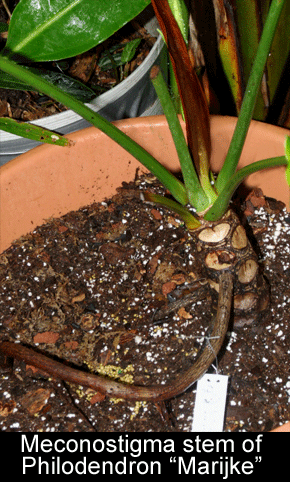 Unfortunately in the case of the
original specimen seen by Joep, the host tree along with
the wild specimen was cut down to allow for the construction of a bridge! However, in 1996 Joep found
berries containing seeds on a specimen of Philodendron goeldii in his
personal collection which had apparently
been pollinated with the pollen
of a neighboring specimen of Philodendron solimoesense.
Both specimens were in flower and are members of Philodendron
subgenus Meconostigma which is composed
of specimens
known to collectors as "tree Philodendron".
Tree Philodendrons may be self
supporting but in the rain forest are more frequently observed growing attached to a host
tree.
Unfortunately in the case of the
original specimen seen by Joep, the host tree along with
the wild specimen was cut down to allow for the construction of a bridge! However, in 1996 Joep found
berries containing seeds on a specimen of Philodendron goeldii in his
personal collection which had apparently
been pollinated with the pollen
of a neighboring specimen of Philodendron solimoesense.
Both specimens were in flower and are members of Philodendron
subgenus Meconostigma which is composed
of specimens
known to collectors as "tree Philodendron".
Tree Philodendrons may be self
supporting but in the rain forest are more frequently observed growing attached to a host
tree.
Philodendron
species within the subgenus Meconostigma are characterized by their stems (base)
which somewhat resemble a "tree" (see photo right). Meconostigma Philodendron species are all but
exclusive to Brazil and the Guiana Shield of northern South America.
Joep would later confirm that both species were found near the site of the
bridge, "I
found P. goeldii along the RN2 in 2006 approximately 5 km from where I
observed the hybrid goeldii x solimoesense in 1995. Solimoesense can
be found everywhere in the Guyanas including the area east and across the
b into Amapa State, Brazil".
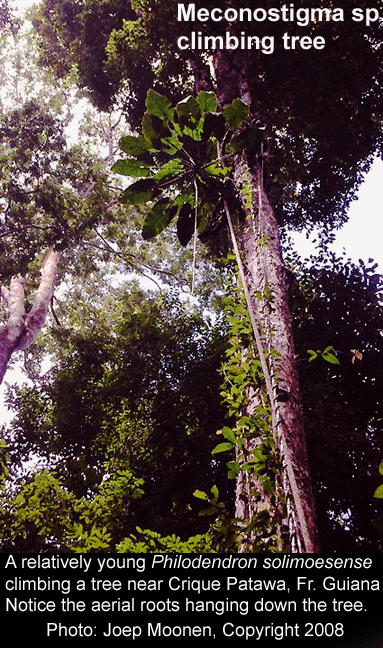 Philodendron goeldii is not known to
naturally cross with other Meconostigma species. Aroid expert Leland
Miyano who spent a great deal of time with legendary Brazilian collector and
artificial pollinator
Roberto Burle-Marx offers this explanation,
"I have not seen
another natural hybrid with Philodendron goeldii...the plant at Roberto's is
supposedly a cross done by Roberto Burle-Marx and Karl Wendlinger...although
it is plausible that it could have occurred in a pollination by a natural
pollinator in Roberto's nursery and the two "discovered" the seedling within
the collection. This plant is considered to be a cross of Philodendron
goeldii and Philodendron speciosum and these two species are not
sympatric...their distributions are far removed one from the other. The
other hybrids I have seen with Philodendron goeldii are also with
Meconostigma that do not share a common habitat....therefore all are
unnatural hybrids. I happen to know the hybridizers...who are not
Cyclocephala."
Leland's reference to Cyclocephala
beetles will soon be explained.
Philodendron goeldii is not known to
naturally cross with other Meconostigma species. Aroid expert Leland
Miyano who spent a great deal of time with legendary Brazilian collector and
artificial pollinator
Roberto Burle-Marx offers this explanation,
"I have not seen
another natural hybrid with Philodendron goeldii...the plant at Roberto's is
supposedly a cross done by Roberto Burle-Marx and Karl Wendlinger...although
it is plausible that it could have occurred in a pollination by a natural
pollinator in Roberto's nursery and the two "discovered" the seedling within
the collection. This plant is considered to be a cross of Philodendron
goeldii and Philodendron speciosum and these two species are not
sympatric...their distributions are far removed one from the other. The
other hybrids I have seen with Philodendron goeldii are also with
Meconostigma that do not share a common habitat....therefore all are
unnatural hybrids. I happen to know the hybridizers...who are not
Cyclocephala."
Leland's reference to Cyclocephala
beetles will soon be explained.
Other crosses with Philodendron goeldii have been artificially created by expert aroid pollinators, but they are not common. Aroid expert Julius Boos explains further, "There is a hybrid in Miami which was crossed by Ron Weeks which has been at the IAS show many times in the past, I believe the parent species are P. goeldii (seed parent) X Philodendron stenolobum which is the pollen parent. It is very much like P. 'Marijke', the difference is the leaves have inherited the 'shine' of Philodendron stenolobum while Philodendron 'Marijke' has duller leaves. There are several other hybrids in which the seed parent is supposed to be Philodendron goeldii, the most interesting ones are those with Philodendron bipinnatifidum as a parent. "
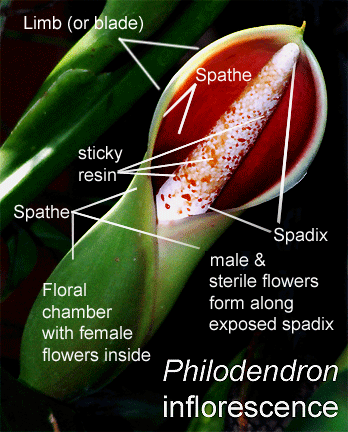 All Philodendron species
are aroids.
An aroid is a plant
that reproduces by producing an inflorescence known to
science as a spathe and spadix.
Many people assume the
spathe is a "flower". which is incorrect,
the
spathe is nothing more than a modified leaf. Within
the inflorescence at sexual anthesis there are very tiny flowers on the spadix
at
the center of the inflorescence.
(see the photo at right for an
explanation of the parts of a
Philodendron inflorescence.
PLEASE NOTE: The inflorescence shown in the illustration to the
right is not
Philodendron 'Marijke'.
All Philodendron species
are aroids.
An aroid is a plant
that reproduces by producing an inflorescence known to
science as a spathe and spadix.
Many people assume the
spathe is a "flower". which is incorrect,
the
spathe is nothing more than a modified leaf. Within
the inflorescence at sexual anthesis there are very tiny flowers on the spadix
at
the center of the inflorescence.
(see the photo at right for an
explanation of the parts of a
Philodendron inflorescence.
PLEASE NOTE: The inflorescence shown in the illustration to the
right is not
Philodendron 'Marijke'.
Once an aroid enters anthesis the spadix produces these tiny flowers, both
male, female along with sterile male flowers. The male flowers produce
pollen at male anthesis and the female flowers, which are hidden from view
inside the lower portion of the spathe known as the floral chamber, are
receptive to that pollen when they become sexually mature. You can see the inflorescence of Philodendron 'Marijke' in the
photo just below (left) by Bernie Moonen.
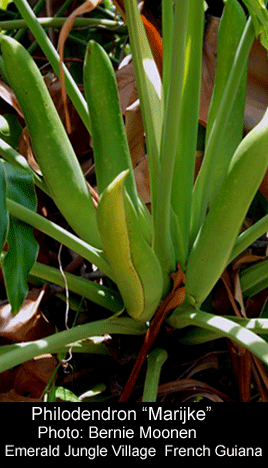
Despite the fact many
plant growers believe the spathe is a "flower", that
assumption is
incorrect. The flowers of an aroid are
very small and can be found on the spadix at
the center
of the inflorescence when the plant is ready to reproduce. In nature an aroid's inflorescence signals it is
ready to
enter sexual anthesis by
emitting a perfume-like odor known scientifically as a pheromone.
The pheromone is propelled as a result of thermogenesis (heat-birth) when
the aroid is at sexual anthesis. The perfume is
attractive to the natural insect pollinator and can be detected at distances of at least 200 meters (650 feet) by the Scarab beetle. The pollinators of aroids are
primarily beetles from the genus Cyclocephala which fly in a
zigzag pattern back and forth through the rain forest in to follow
the pheromone to its source. The pheromone cannot travel in a
straight line due to the variable wind flow through the rain forest
trees.
When Joep planted the seeds
which formed on his specimen of Philodendron goeldii the seeds produced the
plant he chose to name Philodendron 'Marijke'. Both suspected parent Meconostigma species
were situated side by side in Joep's large back yard collection of rain
forest species at his Emerald Jungle Village in French Guiana. Joep
surmises a
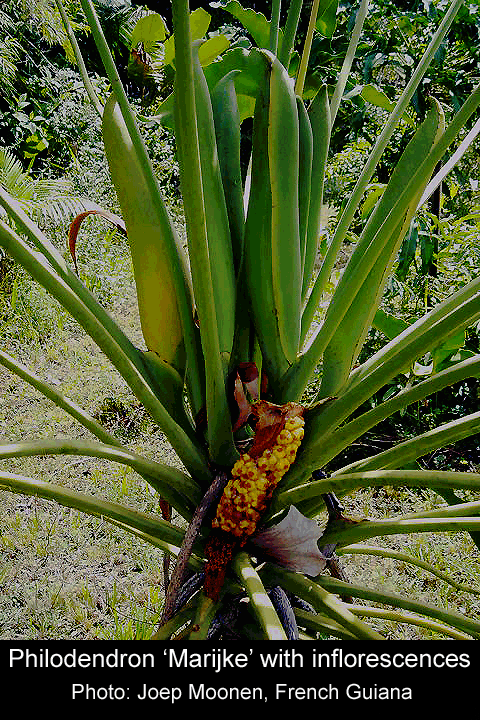 Cyclocephala beetle (commonly known as the Scarab Beetle)
gathered pollen from the sexually mature inflorescence of his specimen of
Philodendron solimoesense and transferred the pollen it to his
specimen of Philodendron goeldii. Therefore, the resulting hybrid specimens
are a
Meconostigma hybrid cross.
Cyclocephala beetle (commonly known as the Scarab Beetle)
gathered pollen from the sexually mature inflorescence of his specimen of
Philodendron solimoesense and transferred the pollen it to his
specimen of Philodendron goeldii. Therefore, the resulting hybrid specimens
are a
Meconostigma hybrid cross.
Originally over 1000 plants were grown from these seeds which were subsequently sent to Europe as seedlings but all were destroyed when the botanical garden discovered they were hybrids and not a true Philodendron goeldii species! Joep suspects there are now only 80 remaining Philodendron 'Marijke' specimens in French Guiana, most of them in his control. The actual number of plants in the hands of private collectors is unknown.
Joep's cultivated specimens grow quite large and the plant enjoys a great deal of sunshine as well as rainfall. Joep stated his plants can easily grow to 6 meters (20 feet). The petioles of Philodendron 'Marijke' are "D" shaped when seen cut as a cross section. The petiole is the portion of the plant that supports each leaf blade. The adaxial leaf surface (upper) is glossy and abaxial (lower) leaf surface is matte. The plant is considered rare and is almost certainly sterile (unable to naturally reproduce). Joep confirms his specimens produce inflorescences and flowers frequently at his Emerald Jungle Village but the berries are infertile and never produce seeds (see photo above, right). As a hybrid, Philodendron 'Marijke' will never be described to science.
It is suspected by entomologists there are
approximately 900 species of Cyclocephala beetles but only about one
half have been scientifically identified.
One of these beetle
species has evolved to be the specific or "assigned" pollinator of
any particular aroid thus helping to keep the species pure. Once the bodies of those "assigned"
pollinators come in contact with the reddish colored resin on the
aroid's spadix
(see illustration above) they collect and hold pollen grains from
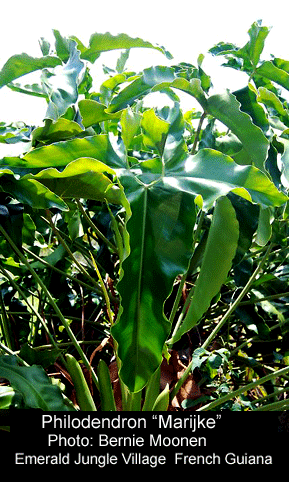 one
inflorescence which is shedding pollen during male anthesis
and transport it to another bloom which is at female anthesis.
Once transferred to the tiny female flowers which are sticky, the result is
pollination leading to the production of berries and seeds. The beetle
in Marc's photo right is Cyclocephala colasi. The
attractive berries are eaten by rain forest inhabitants which spread them
through the forest canopy in their droppings.
one
inflorescence which is shedding pollen during male anthesis
and transport it to another bloom which is at female anthesis.
Once transferred to the tiny female flowers which are sticky, the result is
pollination leading to the production of berries and seeds. The beetle
in Marc's photo right is Cyclocephala colasi. The
attractive berries are eaten by rain forest inhabitants which spread them
through the forest canopy in their droppings.
French aroid pollination expert Dr. Marc Gibernau (GHEE-ber-no) of the University Paul Sabatier in Toulouse, France now suspects the beetles are also attracted to the spadix in the darkness of the forest due to the infrared heat produced during sexual anthesis. In both private and public meetings with Marc in Miami, FL in September, 2008 he explained in a presentation to the International Aroid Society as well as to several of us individually there is a significant increase in temperature above the ambient temperature of the rain forest at night once the inflorescence reaches anthesis. The average Philodendron temperature increase is approximately 12 degrees Celsius (21.6 degrees Fahrenheit) above ambient but a few plant species can increase in temperature by as much as 20 degrees C (36 degrees F). The heat can be so intense it can be felt on the palm of an opened hand held in front of the spadix. On the chart below provided by Marc the spadix shown is Philodendron solimoesense which makes this entire discussion relevant to the pollination of Philodendron 'Marijke'. If you notice the temperature gradients you will see the spadix of Philodendron solimoesense increases in temperature 14 degrees C or close to 25.2 degrees F above the surrounding rain forest ambient temperature.
In photographic documentation
shot with an infrared camera (see below) the "glow" of a sexually mature
Philodendron solimoesense
spadix is "visible" and Marc theorizes the beetles can detect that
infrared heat with a method somewhat
similar to a pilot seeing the glow of a
runway light during the night. Since the beetle uses the spathe and
spadix as a source of food (pollen) and a place for warmth during
its own sexual
reproduction with a mate, the "glow" is an open
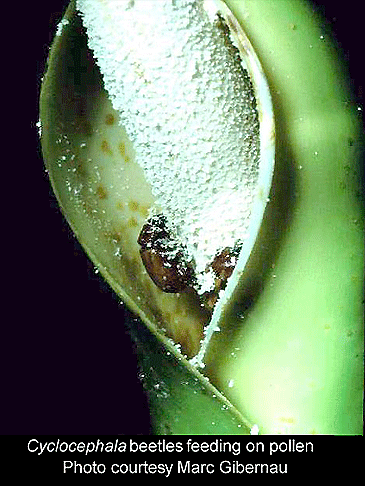 invitation to fly
to that source of food, shelter and warmth. At present, Marc
and his associates are working to prove
the beetle does not actually "see" the infrared heat, but instead
detects it with receptors on their antennae or bodies instead of
seeing it with
their eyes.
invitation to fly
to that source of food, shelter and warmth. At present, Marc
and his associates are working to prove
the beetle does not actually "see" the infrared heat, but instead
detects it with receptors on their antennae or bodies instead of
seeing it with
their eyes.
The chart below was presented at the 2008 International Aroid Society Show and Sale dinner and is used with permission. Marc forwarded these additional comments in a personal email received on October 14, 2008: "My picture (below) is an inflorescence of Philodendron solimoesense. Your Paragraph 9 about anthesis may also need to explain the time shift between male and female phases (protogyny) because people may think an inflorescence can self-pollinate. On day one the female flowers are receptive and the next day the male flowers produce pollen because the flower are synchronized. On the first day the inflorescence is at the female stage and all stigma are receptive for fecundation/pollination by pollen grains. On the next day (2nd day), the stigma are no longer receptive but the anthers are fully ripe (mature) and shed the pollen. In a few species, such as in some Anthurium, these two sexual phases are overlapping and self-pollination may occur. Hence, aroids need pollen vectors (insects) for pollination between different inflorescences. The Cyclocephala beetles carry the pollen from a male-stage inflorescence to a female-stage inflorescence. From the standpoint of a botanist the aroid reproductive structure would be the same as to view the inflorescence, which is composed of many flowers packed together, to functionally "behaves" like a flower."
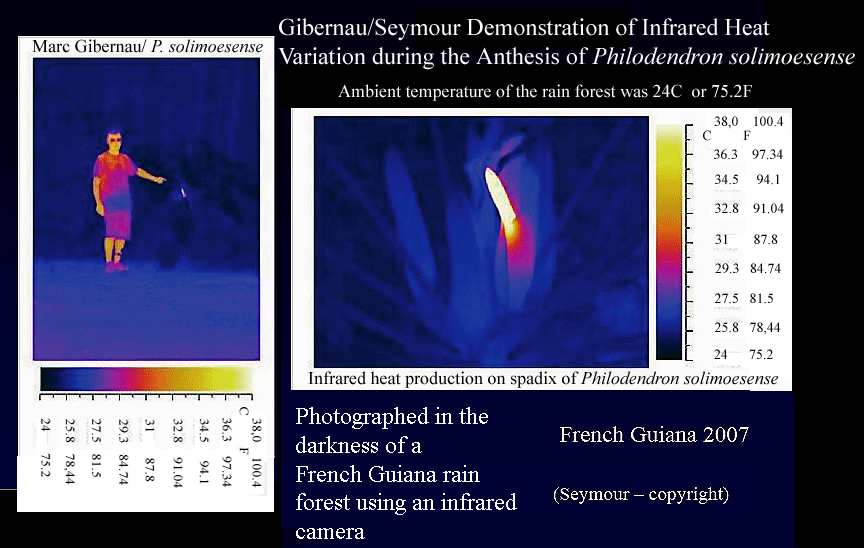
As a result of the Cyclocephala beetle bringing pollen from Philodendron solimoesense to Philodendron goeldii Joep was able to grow viable seeds.
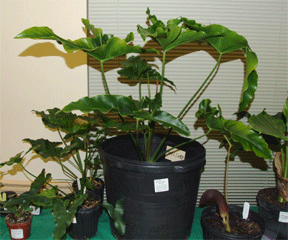 Our
original specimen of Philodendron 'Marijke' was donated to the
International Aroid Society by Loretta Enck, the wife of the late Jim Enck,
for sale at the 2008 International Aroid Society Sale and Auction held during
September. (see the specimen, right) The proceeds
raised from the sale of this and other specimens went to further the work of
the IAS.
Since I have been trying to acquire a specimen of Philodendron 'Marijke' for
years because of my personal friendship with Joep we gladly placed the
winning bid. In early 2010 Joep personally presented a young specimen
of Philodendron 'Marijke' to us when he spent almot one full week in our
home.
Our
original specimen of Philodendron 'Marijke' was donated to the
International Aroid Society by Loretta Enck, the wife of the late Jim Enck,
for sale at the 2008 International Aroid Society Sale and Auction held during
September. (see the specimen, right) The proceeds
raised from the sale of this and other specimens went to further the work of
the IAS.
Since I have been trying to acquire a specimen of Philodendron 'Marijke' for
years because of my personal friendship with Joep we gladly placed the
winning bid. In early 2010 Joep personally presented a young specimen
of Philodendron 'Marijke' to us when he spent almot one full week in our
home.
Julius provided this information regarding the original source of our specimen: "The plant Steve got at auction came from the collection of the late Jim Enck, and was given to him by Joep during a visit by Joep to my home. The plant was from the first (and only?) batch of seed some of which had been sent to a European/Asian nursery and when they turned out not to be pure P. goeldii all were destroyed."
Our specimen is currently (October, 1008) a mid-sized plant with the largest leaf blade (shown at the top of the page) measuring approximately 60cm (24 inches) from the tip of the upper lobes to the base of the leaf.
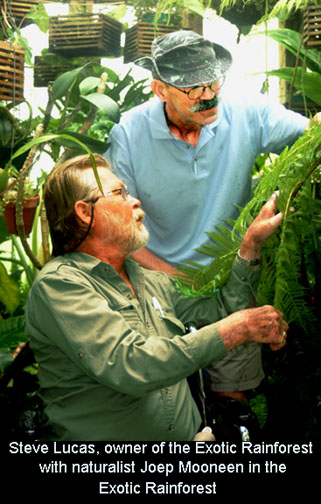 Brazilian female botanist Graziela Maciel Barroso
(1912-2003) described Philodendron goeldii to
science in 1957 and described many
Brazilian species. American botanist Albert Charles Smith (1906-1999) was a director of the National
Museum of Natural History who chaired several important societies such
as the American Society of Plant Taxonomists. Smith described
Philodendron solimoesense to science in 1939.
Brazilian female botanist Graziela Maciel Barroso
(1912-2003) described Philodendron goeldii to
science in 1957 and described many
Brazilian species. American botanist Albert Charles Smith (1906-1999) was a director of the National
Museum of Natural History who chaired several important societies such
as the American Society of Plant Taxonomists. Smith described
Philodendron solimoesense to science in 1939.
Philodendrons are known to be variable and not every leaf of every specimen will always appear the same. Natural variation and morphogenesis are extremely common within aroid species. This link will explain in non-technical language both variation and morphogenesis known to science as ontogeny: Click here.
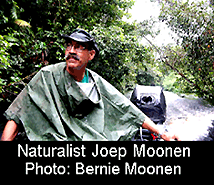 My additional thanks to Marc
Gibernau for his explanations as well as allowing us to use his photograph of Cyclocephala beetles
eating pollen on the spadix of a Philodendron sp..
Marc has
answered many email questions from both myself and Julius Boos in addition to
granting us so much of his time in
Miami in September, 2008. And finally, thanks to Dr. Derek Burch, editor of the
International Aroid Society journal Aroideana and to botanist
Wilbert Hetterscheid for their guidance on
the proper use of the name Philodendron 'Marijke',
to my friends Julius Boos and Leland Miyano for constantly making
invaluable suggestions for many of the pages posted on the Exotic
Rainforest website, and to Russ Hammer for checking for my typos!
At the present time (October, 2008) registration of the name
Philodendron 'Marijke' is underway.
My additional thanks to Marc
Gibernau for his explanations as well as allowing us to use his photograph of Cyclocephala beetles
eating pollen on the spadix of a Philodendron sp..
Marc has
answered many email questions from both myself and Julius Boos in addition to
granting us so much of his time in
Miami in September, 2008. And finally, thanks to Dr. Derek Burch, editor of the
International Aroid Society journal Aroideana and to botanist
Wilbert Hetterscheid for their guidance on
the proper use of the name Philodendron 'Marijke',
to my friends Julius Boos and Leland Miyano for constantly making
invaluable suggestions for many of the pages posted on the Exotic
Rainforest website, and to Russ Hammer for checking for my typos!
At the present time (October, 2008) registration of the name
Philodendron 'Marijke' is underway.
If you enjoy spending time in a rain forest filled with exotic creatures and extremely rare exotic plant species Joep Moonen enjoys introducing you to the rain forests of northeast South America. The Emerald Jungle Village website can be found at http://home.planet.nl/~gumamaus/
Join the International Aroid Society: http://www.exoticrainforest.com/Join%20IAS.html
If you are seeking information on other rare
species, click on "Aroids and other genera in the Collection" at the top and look for the